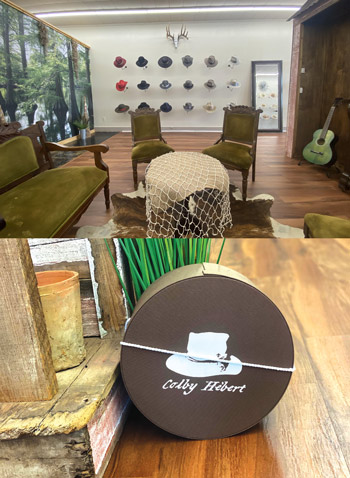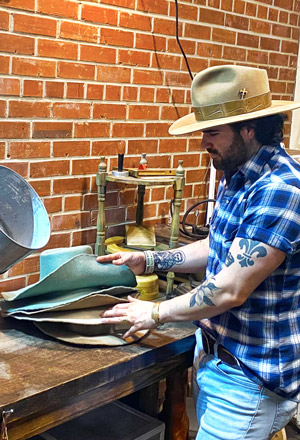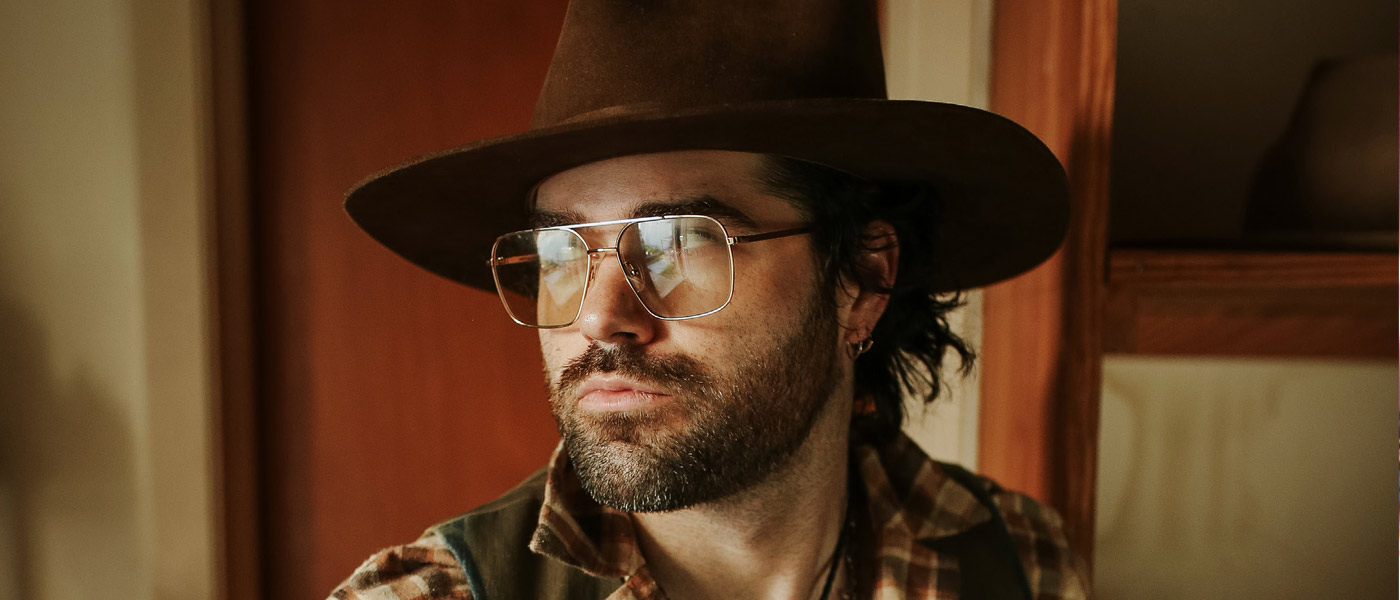Colby Hebert has a tattoo of St. Francis on his right arm and one of Jean Lafitte on his left. One was a friar who cared for the poor and sick, renouncing his family’s substantial wealth while preaching sermons to all of God’s creatures. The other was a French pirate known equally for his detailed knowledge of the meandering waterways leading to the Gulf of Mexico and his love of drinking, gambling and women. The teetotaler and the bon vivant, or as Hebert puts it, “My yin and my yang.” I step into his sunny storefront, still sparkling with newness and the exciting, hopeful energy of a burgeoning business. His custom hat shop is located next to The Wurst Biergarten on Jefferson Street, one of several new and diverse ventures that continue to elevate Lafayette’s downtown district.
I immediately comment that there is no detail ignored, nothing remotely out of place – save for a small bit of ash at the bottom of an incense bowl. I am greeted promptly by Hebert’s assistant, Kat, who says casually that the energy I describe was precisely why she wanted a job there. She summons Hebert, who introduces himself with a warm two-hand handshake, the best kind.
 Hebert is what any southern girl would call a “tall drink of water.” He will probably be embarrassed that I said that, but it is impossible not to notice his effortless style the first time you meet him. His clothing, though casual, looks tailored, and it almost floats softly around his large, fit frame. He has a mess of dark curls that fall perfectly under one of his signature hats. He wears a short beard and rocks jewelry like no one since George Michael.
Hebert is what any southern girl would call a “tall drink of water.” He will probably be embarrassed that I said that, but it is impossible not to notice his effortless style the first time you meet him. His clothing, though casual, looks tailored, and it almost floats softly around his large, fit frame. He has a mess of dark curls that fall perfectly under one of his signature hats. He wears a short beard and rocks jewelry like no one since George Michael.
He is quick to laugh and has an endearing facial expression that is both subtle and quick. Blink and you miss it. He winces slightly on the right side of his face when he discusses something he feels deeply, as though the light of it is unbearably bright. It’s like he sees something you don’t. ‘We are gonna make you a hat’
I ask before the interview if we could perform an actual consultation, the way he would with any new client. He was thrilled with this idea, saying with excitement, “No one has ever asked me to go through my process, so I am gonna do something I have never done in an interview. We are gonna make you a hat.”
He teaches me about my face shape, skin tone, and eye color, and how that has more of an impact on the final color of the hat than my own preferences. I get the feeling that it is as though the hat chooses you, not the other way around. After taking measurements and determining everything from the best material, to the color, to the brim width and the trim that would make a hat that suited me, he takes me into a small Victorian living room set-up in the center of the store and pours me a beautiful, tiny teacup of bourbon.
“Off the record,” he says with a wink. “I joke, but that is part of the process. I take my clients here and we sit and have a discussion about who they are. I want to really get that part right. These hats are made for a lifetime. There are a lot of hat makers who make runway style hats. But for me, it’s important to not lose sight of the fact that the original hatmakers were making hats for everyday wear.” When I ask him where he gets his own sense of personal style, he immediately singles out his parents. “Both of my parents love fashion. They both dress just to look good. My dad’s style has gotten bolder as time has gone by and he has the means to dress better. He’s a country guy, but he has done well for himself over the course of his life.”
Hebert says, “He went from shorts and T-shirts for my brother’s baseball games to having his own style now. He has an eye for nice touches like a great pair of boots or an accessory that just puts a whole look together.” “My mom, though? She’s the icon. Jackie Kennedy and Audrey Hepburn. Intuitive, elegant, graceful. Even if it’s a jogging suit, she’s going to make it look right,” he continues. “She will wear a white shirt and denim jacket, but she’s gonna have a crisp and popped collar. It’s effortless and intuitive, because she owns it.”
We discuss the difference between creating art for art’s sake and creating art when a client actually participates in the final outcome of the product. I question whether anyone has ever explicitly asked for something he knew would look terrible. He belly laughs, recounting a time he opened his New Orleans store to his substantial family. “My dad is one of 13. Half of his siblings all happened to be in New Orleans at once. They all rushed in at the same time one day, and they wanted this and that. It was chaos,” he recalls. “My aunt brings me this bright cayenne red hat, and I was overwhelmed and busy and just sort of thought, ‘Sure, you can have this. I have to take it back.’ And I did. I actually took it off her head,” he says, laughing as he recalls the memory.
“She had all this red in her hair and it was wrong for her skin tone and it just didn’t work. I found her a blue hat that really balanced all her features out, and that’s what she wears now.”
NEW ORLEANS AND LAFAYETTE: COMPLEX, SISTER CITIES
While that New Orleans store has since been relocated to his new downtown Lafayette location, the big city made an even bigger impact on him. We talk at length about New Orleans and Lafayette’s complex sisterhood. We trade opinions on the shared history of the two.
It’s in our blood. Generational trauma. Hard work. Hard times. We don’t need a lot to have a good time. It’s who we are, and who we have to be. — Colby Hebert on what it means to be a Cajun.
I say at some point, “It’s funny how, in a lot of ways, we are the only city that truly understands New Orleans,” to which he deftly replies, “It’s because they are the only city that truly understands us.”
I ask him, as a business owner who has experienced success in both cities, what New Orleans and Lafayette could learn from each other and vice versa. “It’s easier to talk about the people. The negative aspects of both places are gonna address themselves,” he says. “People here have a joie de vivre that is so different from the one in New Orleans. There, everything has to appear a certain way. They also have more access. They are a bigger city. They have more arts, more funding, more infrastructure. Lafayette could learn some of that open-mindedness from them.”
“Here, though, we don’t need as much. We can smoke cigarettes on the patio and joke and drink and talk. It’s in our blood. Generational trauma. Hard work. Hard times. We don’t need a lot to have a good time. It’s who we are, and who we have to be. New Orleans could afford to be a little more like the Cajuns in that respect.”
GENERATIONAL ‘GIFTS’
In addition to being a milliner to the stars (Lauren Daigle recently posted a photo of herself wearing one of his hats), Hebert is a traiteur, a specific type of faith healer native to Louisiana who passes treatments and prayers down through generations. “My grandmother and her father were traiteurs for sure, I don’t know much past that. But I do know it goes all the way back in time to the beginning of my family.” The family realized he had “the gift,” as it is known, at only 14 years old, when he successfully treated a baby for colic.
 When I ask if his creativity gave him a sense of self as a young person, he says, “I had no confidence with my creativity for a long time. I didn’t know how to use my creativity as a
When I ask if his creativity gave him a sense of self as a young person, he says, “I had no confidence with my creativity for a long time. I didn’t know how to use my creativity as a
way to connect with other people.”
Losing a brother when he was just 17 years old was the most formative event in his life. He said his favorite thing about his brother was his confidence. “He gave the gift of confidence to me,” he stated. I ask how many siblings he has, and he does the thing everyone who loses a sibling does. “I have three sib— wait, with him it would be three. I have two now, a brother and a sister.” That experience shaped not only Hebert but his entire family. “As a family, we realized that we experienced something so profoundly sad, it changed our priorities forever. We were not fighting as a family anymore about where the remote control
was or petty stuff like that.”
Hebert beams when he talks about family. Newly married with a second baby on the way, he says that family is ultimately what shaped him. “One thing I can never say enough of is that I had such a great childhood. My parents weren’t perfect and no matter how many faults we all have in my family, it has always been so obvious to me how loved we are by my parents. We are closer than ever. We had a real childhood, and it was full of love.” Like old friends, we hug and promise to stay in touch. He compliments me effusively, telling me that it was the best interview he’s ever done. “Good,” I joke, “because it’s my first one.” “I’ll put an intention into your hat,” he says. “Hopefully you will do more of this.” Indeed.

